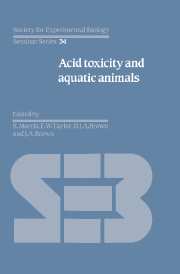Book contents
- Frontmatter
- Contents
- Contributors
- Units, Symbols and Formulae
- Preface
- Introduction: The causes and consequences of surface water acidification
- Invertebrate communities in acid streams
- Fish survival in acid waters
- Field studies on fisheries in acid waters in the UK
- Episodic changes in water quality and their effects on fish
- Acid–base regulation in fishes: 1. Mechanisms
- Acid–base regulation in fishes: 2. Biological responses and limitations
- Intracellular pH regulation and the effects of external acidification
- The physiological problems of fish in acid waters
- Laboratory studies on invertebrate survival and physiology in acid waters
- The physiological problems of crayfish in acid waters
- The effects of hydrogen and aluminium ions on fish gills
- The combined effects of pH and trace metals on fish ionoregulation
- Endocrine responses to acid stress in fish
- Commentary and conclusions
- Index
Acid–base regulation in fishes: 1. Mechanisms
Published online by Cambridge University Press: 05 February 2012
- Frontmatter
- Contents
- Contributors
- Units, Symbols and Formulae
- Preface
- Introduction: The causes and consequences of surface water acidification
- Invertebrate communities in acid streams
- Fish survival in acid waters
- Field studies on fisheries in acid waters in the UK
- Episodic changes in water quality and their effects on fish
- Acid–base regulation in fishes: 1. Mechanisms
- Acid–base regulation in fishes: 2. Biological responses and limitations
- Intracellular pH regulation and the effects of external acidification
- The physiological problems of fish in acid waters
- Laboratory studies on invertebrate survival and physiology in acid waters
- The physiological problems of crayfish in acid waters
- The effects of hydrogen and aluminium ions on fish gills
- The combined effects of pH and trace metals on fish ionoregulation
- Endocrine responses to acid stress in fish
- Commentary and conclusions
- Index
Summary
Introduction
Adjustment of pH is one of the central tasks for homeostatic regulation. Deviations from certain set-point values may result in reduced metabolic performance, due to the enzyme activity of metabolic energy-producing processes having pronounced pH optima. Accordingly, any net endogenous production or exogenous induction of acid–base relevant ions has to be counteracted by equivalent removal from the body fluids in order to maintain steady state conditions.
The regulatory mechanisms available for this purpose are in principle the same in all classes of animals, but are (or can be) utilized to variable extents. The situation of fishes is characterized by their intimate contact with the aqueous environment, including utilization of water as a gas exchange medium. Immersion in water favours ion transfer mechanisms supporting acid–base regulation, but also entails severe restrictions for the regulation of Pco2 in the body fluids. This chapter will briefly delineate and discuss the basic principles of acid–base regulation in fishes with respect to their theoretical limitations, and to their relative importance for the regulation of acid–base homoiostasis in fishes. The selection of references was limited by space, and review articles have been cited wherever possible to provide greater access to the subject. This chapter leads directly into Chapter 6 by J.N. Cameron, which explores the exogenous and endogenous variables affecting acid–base regulation in fishes.
Buffering
Buffering is a mechanism for transient acid–base regulation. Surplus H+ are transferred into the non-dissociated state and masked by association with buffer bases.
- Type
- Chapter
- Information
- Acid Toxicity and Aquatic Animals , pp. 85 - 98Publisher: Cambridge University PressPrint publication year: 1989
- 8
- Cited by



